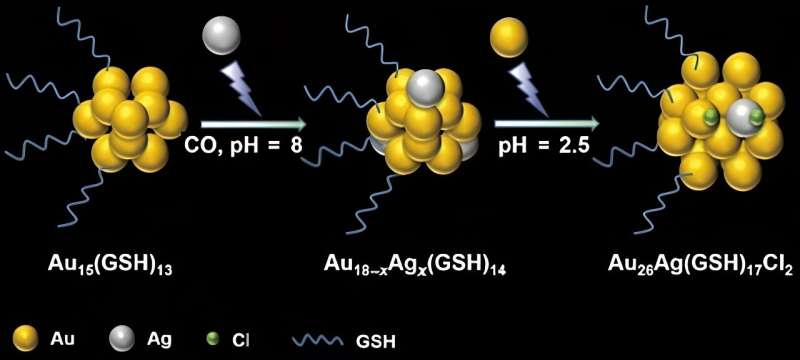
In recent years, ultrasmall metal nanoclusters have unlocked advances in fields ranging from bioimaging and biosensing to biotherapy, thanks to their unique molecular-like properties.
In a study published in the journal Polyoxometalates, a research team from Qingdao University of Science and Technology proposed a design to synthesize atomically precise, water-soluble alloy nanoclusters.
“The novelty of this study is in a new strategy for the synthesis of water-soluble alloy nanoclusters and a further contribution to the fundamental understanding of the alloying mechanism of metal nanoclusters,” said study author Xun Yuan from Qingdao University of Science and Technology.
“The ultimate goal is to develop such alloy nanoclusters as novel nanomedicine,” Yuan said.
Nanoclusters are made of only a few to tens of atoms, and the size of their cores is usually below 2 nanometers (nm). Since the ultra-small size of the clusters is close to the Fermi wavelength of electrons, the continuous band turns discontinuous and becomes molecule-like with discrete energy levels. Consequently, the nanoclusters exhibit unique optical and electronic characteristics.
Recent studies have demonstrated how alloy nanoclusters—synthesized by combining two or more different metals into a monometallic nanocluster framework—can generate new geometric structures and additional functionality. Researchers can “tune” the physical and chemical properties (e.g., optical, catalytic, and magnetic) of metal nanoclusters. Moreover, alloy nanoclusters often exhibit synergistic or new properties that go beyond those of monometallic nanoclusters.
Heightened interest in potential opportunities has spurred recent activity to develop new methods to synthesize alloy nanoclusters. However, while the correlations between alloy nanoclusters’ size, morphology, and composition and their physicochemical properties have been well demonstrated, issues surrounding doping processes and the dynamic responses are not well understood, according to Yuan.
“These unresolved issues are mainly due to the technical limitations in characterizing the alloy atom distribution at the atomic level, especially in real-time tracking of the dynamic heteroatom movement in the alloy nanoparticles during the reactions,” Yuan said.
In addition, most of those methods were exploited for hydrophobic alloy nanoclusters, which may preclude synthesis for water-soluble alloy nanoclusters. Given the wide application of water-soluble alloy nanoclusters in biomedicine and environmental protection, developing novel synthetic strategies for water-soluble alloy nanoclusters at the atomic level is significantly important.
With this goal in mind, Yuan and collaborators found that seeding silver (Ag) ions could trigger the transformation from gold (Au)-based nanoclusters into alloy Au18-xAgx(GSH)14 nanocluster which can be further transformed to composition-fixed Au26Ag(GSH)17Cl2 nanoclusters by gold (Au) ions—with GSH denoting water-soluble glutathione. Moreover, the position of the single Ag atom of Au26Ag(GSH)17Cl2 nanoclusters could be identified on the surface.
“Our results could achieve the atom-level modulation of metal nanoparticles and provide a platform for producing alloy functional nanomaterials for specific applications,” said Yuan. “Additionally, the acquired alloying mechanism may deepen the understanding of the properties-performance of alloy nanomaterials, contributing to the generation of new knowledge in the fields of nanomaterials, chemistry, and nanocluster science.”
In future studies, the researchers will use these alloy nanoclusters for biomedical applications.
More information:
Shuyu Qian et al, Metal ion-induced alloying and size transformation of water-soluble metal nanoclusters, Polyoxometalates (2023). DOI: 10.26599/POM.2023.9140049
Provided by
Tsinghua University Press
Citation:
Researchers develop technique to synthesize water-soluble alloy nanoclusters (2024, January 12)
retrieved 12 January 2024
from https://phys.org/news/2024-01-technique-soluble-alloy-nanoclusters.html
This document is subject to copyright. Apart from any fair dealing for the purpose of private study or research, no
part may be reproduced without the written permission. The content is provided for information purposes only.

